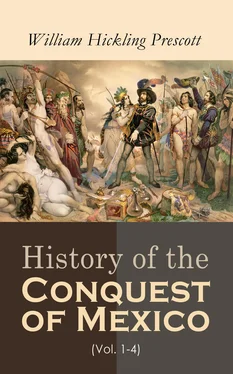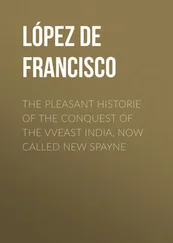All along the Atlantic, the country is bordered by a broad tract, called the tierra caliente , or hot region, which has the usual high temperature of equinoctial lands. Parched and sandy plains are intermingled with others, of exuberant fertility, almost impervious from thickets of aromatic shrubs and wild flowers, in the midst of which tower up trees of that magnificent growth which is found only within the tropics. In this wilderness of sweets lurks the fatal malaria , engendered, probably, by the decomposition of rank vegetable substances in a hot and humid soil. [7]The season of the bilious fever,— vómito , as it is called,—which scourges these coasts, continues from the spring to the autumnal equinox, when it is checked by the cold winds that descend from Hudson’s Bay. These winds in the winter season frequently freshen into tempests, and sweeping down the Atlantic coast and the winding Gulf of Mexico, burst with the fury of a hurricane on its unprotected shores, and on the neighboring West India islands. Such are the mighty spells with which Nature has surrounded this land of enchantment, as if to guard the golden treasures locked up within its bosom. The genius and enterprise of man have proved more potent than her spells.
After passing some twenty leagues across this burning region, the traveller finds himself rising into a purer atmosphere. His limbs recover their elasticity. He breathes more freely, for his senses are not now oppressed by the sultry heats and intoxicating perfumes of the valley. The aspect of nature, too, has changed, and his eye no longer revels among the gay variety of colors with which the landscape was painted there. The vanilla, the indigo, and the flowering cacao-groves disappear as he advances. The sugar-cane and the glossy-leaved banana still accompany him; and, when he has ascended about four thousand feet, he sees in the unchanging verdure, and the rich foliage of the liquid-amber tree, that he has reached the height where clouds and mists settle, in their passage from the Mexican Gulf. This is the region of perpetual humidity; but he welcomes it with pleasure, as announcing his escape from the influence of the deadly vómito . [8]He has entered the tierra templada , or temperate region, whose character resembles that of the temperate zone of the globe. The features of the scenery become grand, and even terrible. His road sweeps along the base of mighty mountains, once gleaming with volcanic fires, and still resplendent in their mantles of snow, which serve as beacons to the mariner, for many a league at sea. All around he beholds traces of their ancient combustion, as his road passes along vast tracts of lava, bristling in the innumerable fantastic forms into which the fiery torrent has been thrown by the obstacles in its career. Perhaps, at the same moment, as he casts his eye down some steep slope, or almost unfathomable ravine, on the margin of the road, he sees their depths glowing with the rich blooms and enamelled vegetation of the tropics. Such are the singular contrasts presented, at the same time, to the senses, in this picturesque region!
Still pressing upwards, the traveller mounts into other climates, favorable to other kinds of cultivation. The yellow maize, or Indian corn, as we usually call it, has continued to follow him up from the lowest level; but he now first sees fields of wheat, and the other European grains brought into the country by the Conquerors. Mingled with them, he views the plantations of the aloe or maguey ( agave Americana ), applied to such various and important uses by the Aztecs. The oaks now acquire a sturdier growth, and the dark forests of pine announce that he has entered the tierra fria , or cold region,—the third and last of the great natural terraces into which the country is divided. When he has climbed to the height of between seven and eight thousand feet, the weary traveller sets his foot on the summit of the Cordillera of the Andes,—the colossal range that, after traversing South America and the Isthmus of Darien, spreads out, as it enters Mexico, into that vast sheet of table-land which maintains an elevation of more than six thousand feet, for the distance of nearly two hundred leagues, until it gradually declines in the higher latitudes of the north. [9]
Across this mountain rampart a chain of volcanic hills stretches, in a westerly direction, of still more stupendous dimensions, forming, indeed, some of the highest land on the globe. Their peaks, entering the limits of perpetual snow, diffuse a grateful coolness over the elevated plateaus below; for these last, though termed “cold,” enjoy a climate the mean temperature of which is not lower than that of the central parts of Italy. [10]The air is exceedingly dry; the soil, though naturally good, is rarely clothed with the luxuriant vegetation of the lower regions. It frequently, indeed, has a parched and barren aspect, owing partly to the greater evaporation which takes place on these lofty plains, through the diminished pressure of the atmosphere, and partly, no doubt, to the want of trees to shelter the soil from the fierce influence of the summer sun. In the time of the Aztecs, the table-land was thickly covered with larch, oak, cypress, and other forest trees, the extraordinary dimensions of some of which, remaining to the present day, show that the curse of barrenness in later times is chargeable more on man than on nature. Indeed, the early Spaniards made as indiscriminate war on the forest as did our Puritan ancestors, though with much less reason. After once conquering the country, they had no lurking ambush to fear from the submissive, semi-civilized Indian, and were not, like our forefathers, obliged to keep watch and ward for a century. This spoliation of the ground, however, is said to have been pleasing to their imaginations, as it reminded them of the plains of their own Castile,—the table-land of Europe; [11]where the nakedness of the landscape forms the burden of every traveller’s lament who visits that country.
Midway across the continent, somewhat nearer the Pacific than the Atlantic Ocean, at an elevation of nearly seven thousand five hundred feet, is the celebrated Valley of Mexico. It is of an oval form, about sixty-seven leagues in circumference, [12]and is encompassed by a towering rampart of porphyritic rock, which nature seems to have provided, though ineffectually, to protect it from invasion.
The soil, once carpeted with a beautiful verdure and thickly sprinkled with stately trees, is often bare, and, in many places, white with the incrustation of salts caused by the draining of the waters. Five lakes are spread over the Valley, occupying one-tenth of its surface. [13]On the opposite borders of the largest of these basins, much shrunk in its dimensions [14]since the days of the Aztecs, stood the cities of Mexico and Tezcuco, the capitals of the two most potent and flourishing states of Anahuac, whose history, with that of the mysterious races that preceded them in the country, [15]exhibits some of the nearest approaches to civilization to be met with anciently on the North American continent.
Of these races the most conspicuous were the Toltecs. Advancing from a northerly direction, but from what region is uncertain, [16]they entered the territory of Anahuac, [17]probably before the close of the seventh century. Of course, little can be gleaned with certainty respecting a people whose written records have perished, and who are known to us only through the traditionary legends of the nations that succeeded them. [18]By the general agreement of these, however, the Toltecs were well instructed in agriculture and many of the most useful mechanic arts; were nice workers of metals; invented the complex arrangement of time adopted by the Aztecs; and, in short, were the true fountains of the civilization which distinguished this part of the continent in later times. [19]They established their capital at Tula, north of the Mexican Valley, and the remains of extensive buildings were to be discerned there at the time of the Conquest. [20]The noble ruins of religious and other edifices, still to be seen in various parts of New Spain, are referred to this people, whose name, Toltec , has passed into a synonym for architect . [21]Their shadowy history reminds us of those primitive races who preceded the ancient Egyptians in the march of civilization; fragments of whose monuments, as they are seen at this day, incorporated with the buildings of the Egyptians themselves, give to these latter the appearance of almost modern constructions. [22]
Читать дальше












